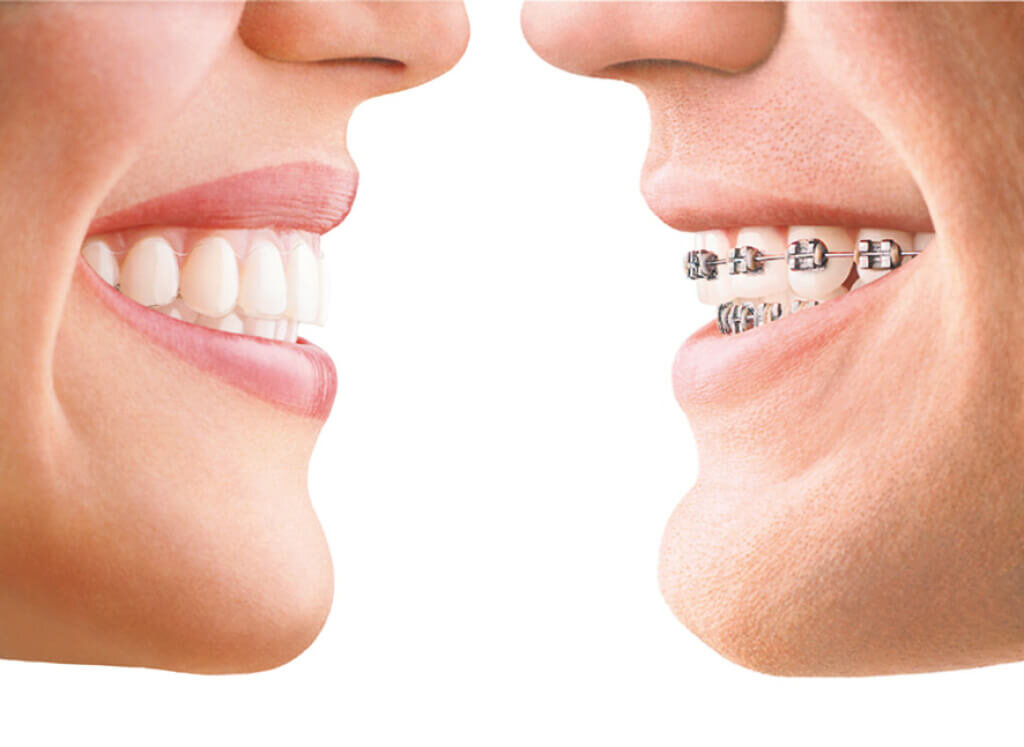Invisalign vs. Standard Dental braces: Which Choice Is Right for You?
When thinking about orthodontic therapy, the selection in between Invisalign and typical dental braces offers a number of important factors that warrant cautious analysis. Invisalign provides a very discreet choice with detachable aligners, while traditional dental braces supply a more visible yet efficient option for extreme imbalance. Each alternative incorporates unique benefits and disadvantages associated to looks, convenience, therapy period, and expense. Comprehending these subtleties is important for making a notified choice that straightens with your personal preferences and way of life. The inquiry continues to be: which choice will best satisfy your orthodontic needs and assumptions?
Introduction of Therapy Options

In comparison, conventional dental braces include metal braces and cords that are adhered to the teeth. This method applies continual pressure with time to achieve placement. While effective for complicated orthodontic concerns, traditional braces require regular brows through for adjustments and can present obstacles in maintaining oral health due to the problem of cleaning up about brackets and wires.
Both choices have their merits, and the option commonly rests on specific dental conditions, way of life choices, and patient compliance. Ultimately, seeking advice from an orthodontic specialist is crucial for figuring out the most appropriate therapy strategy customized to specific demands. Recognizing the subtleties of each option can considerably influence the general success of orthodontic therapy.
Aesthetic Considerations
A substantial element influencing the selection between Invisalign and standard dental braces is the visual appeal each therapy offers. Invisalign aligners are crafted from clear plastic, making them practically invisible when put on.
In contrast, conventional braces contain metal braces and cables, which can be more noticeable. While innovations in orthodontic innovation have caused the advancement of smaller brackets and colored elastics, conventional braces still maintain an even more conspicuous profile. For some individuals, the exposure of dental braces might prevent them from seeking needed therapy.
Ultimately, the option in between Invisalign and conventional dental braces might depend upon personal preferences regarding visual appeals. People who focus on discretion often favor Invisalign, while those that are less concerned concerning visibility might select typical braces. Comprehending the visual implications of each choice is critical for making an informed choice that straightens with one's lifestyle and preferences.
Convenience and Convenience

In regards to comfort, Invisalign aligners are detachable, enabling individuals to appreciate their preferred foods without limitation and keep optimal dental health. Cleaning and flossing are simplified, as the aligners can be secured throughout these routines, whereas typical dental braces require careful navigating around wires and braces.
In contrast, conventional dental braces require routine modifications, making them much less practical investigate this site for those with busy routines. On the whole, the comfort and convenience of Invisalign make it an enticing option for several individuals looking for orthodontic treatment.
Treatment Period and Effectiveness
While both Invisalign and standard braces are efficient in remedying dental misalignments, the duration of treatment can vary dramatically between the two alternatives. Generally, Invisalign therapy can take anywhere from 12 to 18 months, depending upon the complexity of the situation. The clear aligners function by progressively shifting teeth into their desired placements, and normal follow-ups with an orthodontist help make sure development remains on course.
On the other hand, conventional braces typically need a longer dedication, generally varying from 18 months to 3 years. This is due to their set nature and making use of cords and brackets, which can be more effective for intricate instances and severe misalignments (Invisalign). The therapy performance of typical braces is well-documented, as they permit accurate adjustments and higher control over tooth activity
Ultimately, the option in between Invisalign and standard braces might rest see this page on both the expected treatment duration and the specific oral problems at hand. Consulting with an orthodontist is critical, as they can supply customized referrals based upon specific needs, making sure the chosen approach lines up with desired end results and timeframes.
Price Contrast and Insurance Options
Cost plays a considerable function in the decision-making procedure for people considering orthodontic treatment, whether choosing Invisalign or conventional dental braces. Typically, the cost of Invisalign varieties from $3,000 to $8,000, while typical braces generally cost in between $2,000 and $6,000. Elements influencing these expenses include the intricacy of the situation, the duration of treatment, and geographical area.
Insurance policy coverage can significantly influence out-of-pocket expenses. Many oral insurance policy strategies give partial protection for orthodontic treatments, yet the specifics can vary commonly. It is vital for people to assess their insurance plan to figure out the degree of insurance coverage for either choice. Generally, conventional braces may be much more regularly covered by insurance plans compared to Invisalign, which some insurers classify as a cosmetic treatment.
Additionally, several orthodontic practices offer adaptable repayment strategies, making both treatment choices a lot more accessible. People ought to ask about possible financing options and price cuts for ahead of time repayments. Examining the total cost, including insurance coverage benefits and layaway plan, is vital for making an informed choice that straightens with both aesthetic preferences and spending plan factors to consider.

Conclusion
In summary, the choice in between Invisalign and typical braces depends upon numerous aspects, including aesthetic preferences, convenience, treatment period, and cost. Invisalign uses a discreet, removable alternative that helps with oral health and dietary adaptability, while standard braces may be much more appropriate for intricate oral issues and typically come at a reduced price factor. Inevitably, examination with an orthodontist is vital to analyze specific situations and identify the most suitable treatment choice for accomplishing ideal oral placement.
When thinking about orthodontic treatment, the option between Invisalign and traditional dental braces presents several vital variables that warrant careful analysis.Contrasting Invisalign and traditional braces exposes unique treatment options for orthodontic modification.While both Invisalign and conventional braces are efficient in fixing oral misalignments, the period of therapy can vary dramatically between the two choices.Price plays a substantial duty in the decision-making procedure for people taking into consideration orthodontic therapy, whether deciding for Invisalign or typical dental braces.In summary, the option like this in between Invisalign and conventional dental braces pivots on multiple factors, including visual choices, convenience, treatment period, and expense.
Comments on “Top Reasons to Choose Invisalign Over Other Orthodontic Treatments”